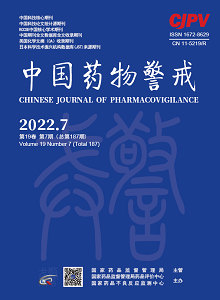|
|
Therapeutic effect of interferon atomization against COVID-19
GE Ziruo, TIAN Di, WANG Aibin, ZHANG Tingyu, REN Xingxiang, QIAN Fang, LI Xingwang, CHEN Zhihai
2022, 19(7):
733-739.
DOI: 10.19803/j.1672-8629.2022.07.08
Objective To evaluate the therapeutic effect of interferon α2b (IFNα2b) aerosol inhalation against COVID-19 and to explore the effect of timing of treatment on the time taken by nucleic acid to become negative. Methods 271 cases of patients with COVID-19 who had been hospitalized in Beijing Ditan Hospital between January 20, 2020 and May 31, 2020 were included. According to whether interferon aerosol inhalation was used during hospitalization, these patients were divided into the interferon treatment group (n=218) and the control group (n=43). After the baseline data of the two groups was matched by the Logistic score nearest distance method, 86 cases in the interferon treatment group and 43 cases in the control group were included in this study. The severity of the disease, 28-day outcomes, the time their conditions began to improve, the length of hospital stay, the time of nucleic acid conversion and the time of imaging inflammation absorption were compared between the two groups. The influence of timing of interferon application on the speed at which nucleic acid turned negative was assessed. Results In terms of disease severity, patients who received IFNα2b aerosol treatment were mainly of the mild type (17.44%) and common type (66.28%), compared with (30.23%) and (46.51%) for the control group in which the proportions of severe (9.30%) and critical (13.95%) patients were higher, and the difference was statistically significant (P=0.032). There was difference in the 28-day outcomes of patients between the two groups. More patients were transferred to ICUs or died in the interferon treatment group than in the control group (P=0.011). The interferon treatment group improved more significantly than the control group (P=0.030). In terms of symptoms, the incidence of fever in the interferon treatment group was lower than that of the control group (P<0.001). As for laboratory indicators, the proportion of abnormal WBC and NE on the 14th day of admission and the proportion of abnormal NE on the 28th day in the interferon treatment group were lower than those of the control group (P=0.015, 0.015, 0.014). The proportion of patients whose nucleic acid test results turned negative after receiving interferon treatment within 7 days of admission was significantly higher than among patients who received medication 7 days after admission (P=0.047). Conclusion Aerosol inhalation of IFNα2b can help to improve the clinical conditions of patients with COVID-19 and reduce the severity of the disease. Early use of IFNα2b can quicken the rate at which nucleic acid turns negative.
References |
Related Articles |
Metrics
|
